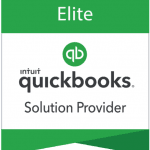As software has come to be used for more and more functions from administrative needs like accounting and HR, to sales to operational needs like inventory control and distribution, companies have often implemented solutions on an as-needed basis. Accounting software is usually an immediate need at or at least shortly after startup. A new company may manage HR with nothing more sophisticated than a spreadsheet until its staff reaches a point at which something more powerful is needed. Until the business actually has a salesforce (as opposed to one person dealing with all customers) management may not even have a need for a customer relationship management (CRM) system.
When you think about it, this type of “patchwork” approach is certainly understandable. The cost (or at least perceived cost) of multiple software systems may be prohibitive in a company’s early stages, or at the very least management may consider those funds to be better spent elsewhere. In addition, the time and energy of the owner is focused on growing the business rather than on growing the infrastructure of the business.
However, the eventual result is a cluster of software systems that most likely do not “talk” to each other, or if they can are able do so only through some convoluted process like exporting data from one system into a common file format (.csv or .txt, for example) and importing it into another. This produces frequent errors, unnecessary labor spent on manual data transfer processes, and reporting that is very limited or else requires extensive manual manipulation to produce something of true value. When you hear IT personnel talking of integrating “legacy” systems—perhaps in the case of a newly-acquired company—this is the environment they are describing.
Sage ERP Editions
Sage offers a line of ERP—enterprise resource planning—software designed for the needs of small to medium enterprises (SMEs). Sage 100 ERP is intended for SMEs needing accounting and operations management systems. Sage 300 ERP adds enhanced accounting and inventory capabilities such as multicurrency management, and Sage 500 ERP scales up for medium to large enterprises particularly in the manufacturing and distribution sectors. Two other available options are Sage ERP X3, also intended for larger companies and offering such capabilities as multiple language support for multinational operations, and Sage 300 Online, which is a cloud-based version of Sage 300. These various platforms integrate accounting, HR, CRM, inventory management, manufacturing, supplier management, and reporting into a single suite and all of these Sage ERP editions allow you to accept credit card payments as well as ACH payments.
Sage Integrated Credit Card Processing
As one would expect with any premiere accounting system, the Sage ERP packages offer the ability to process credit cards from within the system. Even in a business-to-business environment, offering customers a credit card payment option is increasingly important, as companies and even government agencies may well pay with a credit card (usually referred to as a “purchasing card” in these settings) to improve accounts payable and cash flow management, especially when vendors include Level 3 data that automatically identifies the type of merchandise purchased.
Increase Efficiency And Cash Flow While Reducing Costs
Marketing research has shown that when you accept credit card payments, you can increase sales by anywhere from 15 to 50 percent (although the higher end of that range is typically reserved for retail environments) and enhance customer satisfaction while improving cash flow and reducing time spent on collections. But integrating credit card payment and accounts payable systems yields even greater benefits. An Association for Financial Professionals survey of businesses across a wide range of annual revenues revealed that almost 90 percent of respondents had experienced improved efficiency in posting and reconciliation, and around three-quarters had accomplished a reduction in costs and/or staff by implementing such integration. Other reported benefits included improved working capital, improved relations with trading partners, and for 20 percent of companies with less than $1 billion in annual revenue, a reduction in days sales in receivables (a quick measure of how much of a company’s revenue is pending payment from customers).
PCI Compliance And Security
A major issue for any business that accepts credit card payments is PCI compliance—the card data security protocols that reduce the likelihood of breaches and card data theft that many major retail chains such as Target have suffered in recent years. In order to achieve compliance and maximize security, beginning with Sage ERP 100 2013 Sage moved credit card data out of the ERP system itself and into an adjunct program called Sage Exchange Vault. This separate module stores and protects the data, which eliminated the need for Sage to subject all future versions of its ERP software to PCI compliance testing. A Credit Card Purge Utility automatically ensures that no credit card data is held in Sage ERP.
Sage Payments Setup And Install
Preparing Sage ERP for integrated credit card processing is not difficult. The first and most important step is to have a Sage Integrated Merchant Account. If you don’t have this set up, give us a call at 866.949.7267 and we can set it up at no cost in about 24 hours. Once your account is active, we can walk you through the installation to make sure that everything is setup correctly in including running test transactions to make sure that your system is live. Here are the basic installation steps below:
- In the Library Master Main menu, select Company Maintenance and enter the company code of the company that will be using the Credit Card Processing module.
- Select the Credit Cards tab and check the Enable Credit Card Processing box.
- In cases where card data stored in an older version of Sage ERP was migrated into Sage Exchange Vault, it will also be necessary to enter the virtual terminal ID and merchant key in this tab.
- In the Accounts Receivable Setup menu, select Payment Type Maintenance.
- Enter the credit card type (VISA, MasterCard, etc.) that you are setting up into the Payment Type field and select Credit Card from the Payment Method menu.
- Enter the virtual terminal ID and merchant key in the appropriate fields, complete any additional necessary data fields for that card type, and click Accept.
- Repeat these steps for each card type that you will accept.
- In the Accounts Receivable Setup menu, select Accounts Receivable Options.
- Select the Entry tab and check the Allow Credit Cards check box, and then click Accept.
(Keep in mind that specific steps may change with new versions of the software.)
Once credit card integration is installed and you can accept credit card payments in Sage ERP, users gain access to a variety of benefits. In addition to typical credit card payments by phone, e-commerce, or even mail, Sage ERP can create electronic invoices with a “click to pay” link, eliminating the need for either you or your customer to generate a paper document or mail anything—potentially reducing the invoicing and payment cycle from a typical 30 days to a matter of minutes. Payments can also be processed from the Sales Order or eBusiness Manager modules as well as from Accounts Receivable, so more than just the accounting staff can accept payments from customers.
Sage Mobile Payment Processing
Sage ERP also offers two mobile modules, enabling field service or sales staff to set up new customers, create quotes, enter orders, and accept credit card payments remotely. Just as with payments processed from the desktop, all entries are automatically synchronized with the company’s data in Sage ERP in real time. Sage Mobile Sales provides the salesperson with all customer data (and the ability to edit it as needed) and an electronic version of the company’s catalog with the ability to verify product availability in real time, create and e-mail quotes, enter orders, and accept payment on the spot. Sage Mobile Service is geared toward field technicians and includes such capabilities as schedule and route optimization, on-the-fly job assignments, access to customer information and history, and the ability to take before and after photos at the worksite. Technicians have the ability to modify work orders based on additional time spent or parts used on a job as needed, capture customer signoff on job completion, and of course accept payment before departing.
Just as Intuit does, Sage offers an in-house merchant processing solution called Sage Payment Solutions. With our Sage Payment integration, we include the ERP Credit Card module for free with no startup costs or set up fees making the choice to fully integrate credit card payments into Sage an easy choice. Your payment options don’t stop with routine credit card transactions as it is just as easy to set up automatic recurring billing, and the same system can process payments by ACH for customers who prefer an electronic solution but do not have access to a credit or purchasing card.
Save Time And Money
Rates offered through Paygration are customized to your type of business as well as how you do business with the ultimate goal being to integrate payments into your Sage software and at the same time, reduce your current processing costs. Of course, a variety of factors affect the actual rates charged to any given business. The nature of the business itself is one, since some business sectors are inherently riskier for merchant processors than others. The proportion of swiped to keyed transactions is another, and the types of cards accepted will also play a part. However, the Level 3 data that Sage ERP is able include with government and purchasing cards will reduce the costs of processing those card types. On average the processing rates for most business and client types start well below 1% .
The various Sage ERP platforms represent a powerful alternative to the patchwork of legacy software systems that many SMEs currently face. The ability to integrate critical business functions including accounting, HR, inventory management, CRM, purchasing and supplier management, and reporting into a single system provides significant improvements in efficiency, reductions in cost, and increases in productivity. Integrating credit card processing into this system only enhances the benefits, reducing time spent on manual processes that only introduce additional opportunities for error while improving cash flow and decreasing time spent on collections.
Have Questions? Need Help?
As a Sage Payments Partner, we have the flexibility and expertise to allow you to accept credit card payments in Sage ERP software. The net result is a savings of both time and money. Give us a call and in just a couple minutes, we can tell you the best option to accomplish what you need and the easiest way to get you up and running. For more information, you can call us directly at 866-949-7267 or click here to send us a message.






